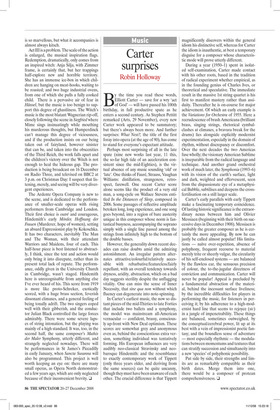Carter surprises
Robin Holloway
By the time you read these words, Elliott Carter — save for a wry ‘act of God’ — will have passed his 100th birthday, in full productive spate as he enters a second century. As Stephen Pettitt remarked (Arts, 29 November), every new Carter work appeared to be summatory; but there’s always been more. And further surprises: What Next?, the title of the first foray into opera (at the age of 90), has come to stand for everyone’s expectant attitude.
Perhaps most surprising of all in the late spate (nine new works last year, 11 this, the so-far high tide of an acceleration consistent since the mid-Eighties), is the virtual absence of any music sounding ‘old’ or ‘late’. One thinks of Fauré, Strauss, Vaughan Williams: distillation, strangeness, retrospect, farewell. One recent Carter score alone seems like the product of a very old man, a song-cycle on Wallace Stevens entitled In the Distances of Sleep, composed in 2006. Some passages of reflective amplitude betoken long, long experience, and one song goes beyond, into a region of bare austerity unique in this composer whose norm is fantastical busyness, accompanying the soprano simply with a single line passed among the strings from infinitely high to the bottom of the double basses.
However, the generality down recent decades can raise doubts amid the admiring astonishment. An irregular pattern alternates attractive/colourful/relatively accessible with rebarbative/featureless/fairly repellant, with an overall tendency towards dryness, aridity, abstraction, which on a bad day suggests sterility despite the unflagging vitality. One can miss the sense of Inner Necessity, that sine qua non without which fluency can degenerate into note-spinning.
In Carter’s earliest music, the now so distant pieces of the mid-Thirties to late Forties that include two ballets and a symphony, the model was mainstream all-American vernacular — confident, brassy, consciously up-front with New Deal optimism. These scores are somewhat grey and anonymous even as, behind the conscientious extra version, something individual was tentatively forming. His European influences are very audibly neo-classical Stravinsky and neobaroque Hindemith: and the resemblance to exactly contemporary work of Tippett (only three years older, and deriving from the same sources) can be quite uncanny, though they must have been unaware of each other. The crucial difference is that Tippett magnificently discovers within the general idiom his distinctive self, whereas for Carter the idiom is inauthentic, at best a temporary disguise for a composer whose characteristic mode will prove utterly different.
During a year (1950–1) spent in isolated self-examination, Carter made contact with his other roots, based in the tradition of radical experiment whether empirical, as in the founding genius of Charles Ives, or theoretical and speculative. The immediate result in the massive 1st string quartet is his first to manifest mastery rather than assiduity. Thereafter he is on-course for major achievement. Of which an early example is the Variations for Orchestra of 1955. Here a recrudescence of brash Americana (brilliant brass, singing strings, rhetorical cymbalclashes at climaxes, a bravura break for the drums) lies alongside explicitly modernist experimentation, especially in the domain of rhythm, without discrepancy or discomfort. Over the next decades the two Americas fuse wholly; the visionary American Sublime is inseparable from the radical language and technique. And another grand orchestral work of much later, the Symphonia (1993–6) with its vision of the earth’s surface, light and dark, weighted and effervescent, seen from the dispassionate eye of a metaphysical Bubble, subtilises and deepens the crossfertilisation on a still larger scale.
Carter’s early parallels with early Tippett make a fascinating temporary coincidence. Of lasting historic significance is the extraordinary nexus between him and Olivier Messiaen (beginning with their birth on successive days in December 1908). Messiaen is probably the greater composer as he is certainly the more appealing. By now he can justly be called almost popular! His limitations — naïve over-repetition, absence of polyphony, frequent recourse to material merely trite or sheerly vulgar, the circularity of his self-enclosed systems — are balanced by the flawless ear, the sensuous precision of colour, the to-the-jugular directness of conviction and communication. Carter will never be popular! Appeal is precluded by a fundamental abstraction of the material, behind the incessant surface liveliness; by the incredible difficulties for players in performing the music, for listeners in perceiving it; by his adherence to a high-modernist hard line that seems to rejoyce (sic) in a jungle of impenetrability. These things are balanced, sometimes outweighed, by the conceptual/cerebral power, lit up at its best with a vein of impressionist poetic fantasy; and the boundless sense of adventure — most especially rhythmic — the modulations between momentums and textures that can stratify succession and simultaneity into a new ‘species’ of polyphonic possibility.
Put side by side, their strengths and limits are as remarkably compatible as their birth dates. Merge them into one, there would be a composer of protean comprehensiveness. ❑






















































































































 Previous page
Previous page